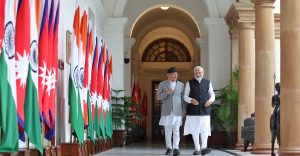Nepali Prime Minister Pushpa Kamal Dahal’s four-day official visit to India from May 31 to June 3 was his first foreign visit after his swearing-in as prime minister in December 2022. The visit happened after multiple postponements.
During the visit, Dahal met Indian Prime Minister Narendra Modi, External Affairs Minister S. Jaishankar, National Security Advisor Ajit Doval, and Foreign Secretary Vinay Mohan Kwatra, among others.
Nepali prime ministers look upon a visit to New Delhi as a “rite of passage” and have usually chosen the Indian capital as the destination of their first foreign visit. However, in 2008, when he became prime minister for the first time, Dahal headed to Beijing first, which irked India. This time, Dahal postponed opportunities to visit China waiting for a call from India.
While seven pacts in the areas of trade, energy and infrastructure were signed by Nepali and Indian officials during Dahal’s visit to New Delhi, the visit exposed the inherent dichotomy in Nepal-India relations.
First, Dahal’s visit to New Delhi and its reporting in Nepal expose the latter’s inherent “inferiority complex” vis-à-vis India. Meenakshi Lekhi, India’s junior minister for external affairs, welcomed Dahal at the Indira Gandhi International Airport.
Social media made fun of New Delhi for welcoming Dahal not on a red carpet but on a bedsheet. While gestures matter in diplomacy, it matters more to those who are “insecure.” In Nepal, many social media users saw it as a representation that India looks down on Nepal. Any nation confident of sovereignty and sovereign equality would have largely brushed it aside.
This, however, reveals the asymmetry in the interests between India and Nepal. India is central to the Nepali economy, politics, and diplomacy. Meanwhile, Nepal is not central to India. It also manifested in Dahal’s language in his press statement with Modi. Dahal implicitly appealed to India’s goodwill in “requesting” that Modi grant Nepal non-reciprocal market access to India and air entry routes, among others items of discussion.
Although Modi has reiterated India’s “neighborhood first policy” often, India as the fifth largest economy globally, is focused on the world beyond its neighborhood. Nepali analysts and people need to internalize this reality.
Second, Nepal and India made critical progress in energy cooperation. Building upon the Joint Vision Statement on Power Sector Cooperation signed during former Prime Minister Sher Bahadur Deuba’s New Delhi visit in April 2022, India agreed to import 10,000 MW of hydroelectricity in the next 10 years. The two sides also signed a long-term power trade agreement, which means that Nepal will not have to negotiate power agreements annually. Currently, Nepal exports 450 MW of hydroelectricity to India.
India also showed a willingness to facilitate the export of 50 MW of hydropower from Nepal to Bangladesh using the Indian power grid. While it still needs trilateral agreement, this is a positive regional development. The region’s energy demand is increasing rapidly, and Nepal could provide cleaner and renewable energy. It would not only provide Bangladesh and India with energy but also help them achieve climate change targets.
Nepal also agreed to two Indian companies constructing the Lower Arun Hydropower Project and the Phukot Karnali Hydropower Project, with a combined capacity of more than 1,100 MW. This further increases Indian investment in Nepal’s hydropower sector. Additionally, Indian investment in Nepali hydropower is critical because Indian policy bans the import of power from countries with which it does not have a bilateral agreement. In effect, it would mean that India will not import power developed by Nepal with Chinese investment or constructed by a Chinese company.
This poses two risks for Nepal though Nepal stands to gain from power trade. Firstly, it could lead to Indian companies developing hydropower in Nepal and importing it to India with little benefit for the country. Secondly, it could lead to monopsony, and India would be in a pivotal position to dictate the terms of power trade.
On petroleum energy, Kathmandu and New Delhi agreed to extend the Motihari-Amlekhgunj petroleum pipeline to Chitwan and construct another cross-border pipeline from Siliguri to Jhapa on a grant basis. Similar agreements and inaugurations of Integrated Check Posts (ICPs) and railways help facilitate trade and connectivity between the two nations.
Third, India implicitly accepted that there are some border disputes. In a press statement, Modi said, “We will solve all issues, whether it is of boundary or any other issue” to take the relationship higher than the Himalayas. Dahal raised the border dispute and even discussed possibly resolving the border via a land swap deal.
It marks some progress on the border dispute, but Dahal’s statement caused a tremor in Nepal. It was clear from the reactions of senior leaders that Dahal had not discussed such a scenario with his coalition partners or the main opposition parties. Such issues of national importance that involve territorial integrity should have been extensively debated in Nepal before his Delhi visit. If the prime minister was only testing the waters, he should have not spoken about it publicly and loosely.
Finally, the visit was also remarkable by what was not discussed between Dahal and Modi. Dahal did not raise the Gurkha recruitment issue, which was halted last year after India announced the Agnipath scheme. Similarly, Dahal did not raise the issue of the Akhand Bharat mural in the new Indian parliament building, which reportedly includes parts of other South Asian countries, including Nepal, in a map of India.
Dahal’s team announced the likely dates of his Beijing visit while he was in India. This may have been done to assuage Beijing’s concerns and aimed at showing that Nepal practices a ‘balanced’ foreign policy.
However, it was ill-advised. It shows that Nepal continues to hyphenate relations with India and China and is perpetually worried about how China sees its engagement with India and vice-versa.













